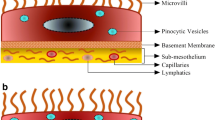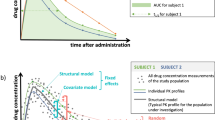Abstract
A Physiologically based pharmacokinetic model was used to describe the distribution and elimination of ceftriaxone in the rat. To validate the practical application of the model, the effect of caffeine on the model was also examined. The model consisted of eleven compartments representing the major sites for ceftriaxone distribution including carcass which served as a residual compartment. Elimination was represented by renal and hepatic (metabolic biliary) excretion with GI secretion and re-absorption. The drug concentrations in most of the tissues were simulated using flow limited equations while brain levels were simulated using membrane limited passive diffusion distribution. The experimental data were obtained by averaging the concentration of drug in the plasma and tissues of five rats after i.v. injection of ceftriaxone 100 mg/kg without and with caffeine 20 mg/kg. The data for the amount of ceftriaxone excreted in urine and gut contents were used to apportion total body clearance. HPLC with UV detection was used for the assay with 0.1–0.2 μ g/ml sensitivity. The great majority of drug concentrations with and without caffeine show reasonably good agreements to the simulation results within 20%. The effect of caffeine on renal and hepatic clearances was apparent with 18.8% and 18.6% increase in the model values, respectively.
Similar content being viewed by others
Literature Cited
Ichimura, F., Yuokogawa, K., Yamana, T., Tsuji, A. and Mizukami: Physiological pharmacokinetic model for pentazocine. I. Tissue distribution and elimination in the rat.Int. J. Pharm. 15, 321 (1983).
Farris, F.F., King, F.G., Dedrick, R. and Litters, R.L.: Physiological model for pharmacokinetics of cis-dichlorodiamine platinum (II) (DDP) in the tumored rat.J. Pharmacokin. Biopharm. 13, 13 (1985).
Bowman, W.C. and Rand, M.J.:Textbook of Pharmacology, 2nd ed., Blackwell Scientific Publications, London. p. 27 (1980).
Stephenson, P.E.: Physiologic and psychotropic effects of caffeine on man.J. Am. Dietetic Assoc. 71, 240 (1977).
Vestal, R.E., Norris, A.H., Tobin, J.D., Cohen, B.H., Shock, N.W. and Andres, R.: Antipyrin metabolism in man: Influence of age, alcohol, caffeine and smoking.Clin. Pharmacol. Therap. 18, 425 (1975).
Mitoma, C., Lombrozo, L., LeValley, S.E. and Dehn, F.: Nature of the effect of caffeine on the drug metabolizing enzymes.Arch. Biochem. Biophysics,134, 434 (1969).
Wagner, S.M., Mekhjian, H.S., Caldwell, J.H. and Thomas, F.B.: Effects of caffeine on fluid transport in the small intestine.Gastroenterology,75, 379 (1978).
Kwon, K.I. and Bourne, D.W.A.: Effect of caffeine on ceftriaxone disposition and plasma protein binding in the rat.J. Pharmacokin. Biopharm. 14, 397 (1986).
Brisson, A.M. and Fourtillan, J.B.: Determination of cephalosporins in biological material by reversed phase liquid column chromatography.J. Chromatography,223, 393 (1981).
Chen, H.G. and Gross, J.F.: Estimation of tissue-to-plasma partition coefficients used in physiological pharmacokinetic models.J. Pharmacokin. Biopharm. 7, 117 (1979).
Cocci, M., Siniscalchi, C., Rogato, F. and Valerini, A.: Free fatty acid levels in habitual coffee drinkers in relation to quantities consumed, sex and age.Ann. Nutr. Metab. 27, 477 (1983).
Acheson, K.J., Zahorska-Markiewicz, B., Anantharaman, K. and Jequier, E.: Caffeine and coffee: their influence on metabolic rate and substrate utilization in normal weight and obese individuals.Am. J. Clin. Nutri. 33, 989 (1980).
Jung, R.T., Shetty, P.S., James, W.P.T., Barrand, M.A. and Callingham, B.A.: Caffeine: its effect on catecholamines and metabolism in lean and obese humans.Clin. Sci. 60, 527 (1981).
Kwon, K.I., Bourne, D.W.A. and Ho, P.C.: Effect of caffeine on the plasma protein binding and the pharmacokinetics of ceftriaxone.J. Pharm. Pharmacol. 37, 836 (1985).
Cohen, S. and Booth, G.H.: Gastric acid secretion and lower-esophageal-sphincter pressure to coffee and caffeine.N. Engl. J. Med. 293, 897 (1975).
Tsuji, A., Yoshikawa, T., Nishide, K., Minami, H., Kimura, M., Nakashima, E., Terasaki, T., Miyamoto, E., Nightingale, C.H. and Yamana, T.: Physiologically based pharmacokinetic model for β-lactam antibiotics. I.: Tissue distribution and elimination in rats.J. Pharm. Sci. 72, 1239 (1983).
Jain, R.K., Gerlowski, L.E., Weissbrod, J.M., Wang, J. and Pierson Jr., R.N.: Kinetics of uptake, distribution, and excretion of zinc in rats.Ann. Biomed. Engineering,9, 347 (1981).
Gabrielsson, J.L. and Paalzow, L.K.: A physiological pharmacokinetic model for morphine disposition in the prognant rat.J. Pharmacokin. Biopharm. 11, 147 (1983).
Author information
Authors and Affiliations
Rights and permissions
About this article
Cite this article
Kwon, KI., Bourne, D.W.A. Physiological pharmacokinetic model of ceftriaxone disposition in the rat and the effect of caffeine on the model. Arch. Pharm. Res. 13, 227–232 (1990). https://doi.org/10.1007/BF02856526
Received:
Issue Date:
DOI: https://doi.org/10.1007/BF02856526




